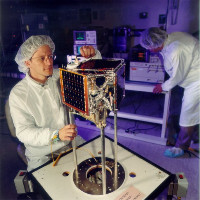| Satellite name | SNAP-1 (Surrey Nanosatellite Applications Platform) |
|---|---|
| Form factor | Nanosatellite |
| Units or mass | 6.5 kg |
| Status | Was operational until ? |
| Launched | 2000-06-28 |
| NORAD ID | 26386 |
| Deployer | Custom |
| Launcher | Kosmos-3M |
| Entity name | Surrey Satellite Technology |
| Institution | Company |
| Entity | Commercial |
| Country | UK |
| Partners | University of Surrey |
| Oneliner |
SNAP-1 nanosatellite, weighing 6.3kg, had a number of firsts, including what we believe to be the first nanosat with propulsion. |
| Description |
SNAP-1 (Surrey Nanosatellite Applications Platform) was designed and built as a research mission by a joint academic-commercial team at the Surrey Space Centre and SSTL - funded entirely by SSTL. The objective of SNAP-1 is to demonstrate in orbit the capabilities of advanced, highly integrated nanosatellites and their use as autonomous robots for observing orbiting space vehicles. In addition to the machine vision payload, SNAP-1 carries a miniature propulsion system, the size of a pencil, using butane. This is currently being used to manoeuvre the nanosatellite to rendezvous with the Chinese Tsinghua 1 microsatellite. Also on-board this tiny spacecraft are other miniature systems: a momentum wheel and magnetorquers for 3-axis attitude control; a GPS receiver for autonomous orbit determination; a 220 MHz 'StrongARM' 1100 on-board computer for housekeeping and high level vision functions; and an S-band communications system. SNAP-1 imaging capabilities:
SNAP-1 mission achievements:
|
| Notes | |
| Sources | [1] [2] [3] [4] |
| Photo sources | [1] |
| Keywords | Propulsion |
Last modified: 2024-12-15

